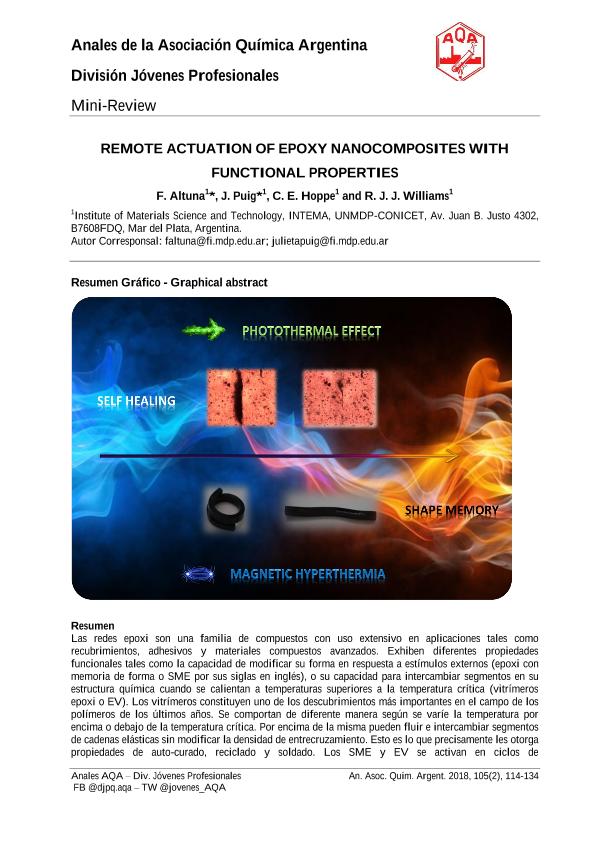Mostrar el registro sencillo del ítem
dc.contributor.author
Altuna, Facundo Ignacio

dc.contributor.author
Puig, Julieta

dc.contributor.author
Hoppe, Cristina Elena

dc.contributor.author
Williams, Roberto Juan Jose

dc.date.available
2019-11-29T19:59:04Z
dc.date.issued
2018-10
dc.identifier.citation
Altuna, Facundo Ignacio; Puig, Julieta; Hoppe, Cristina Elena; Williams, Roberto Juan Jose; Remote actuation of epoxy nanocomposites with functional properties; Asociación Química Argentina; Journal of the Argentine Chemical Society; 105; 2; 10-2018; 114-134
dc.identifier.issn
0365-0375
dc.identifier.uri
http://hdl.handle.net/11336/91020
dc.description.abstract
Las redes epoxi son una familia de compuestos con uso extensivo en aplicaciones tales comorecubrimientos, adhesivos y materiales compuestos avanzados. Exhiben diferentes propiedadesfuncionales tales como la capacidad de modificar su forma en respuesta a estímulos externos (epoxi conmemoria de forma o SME por sus siglas en inglés), o su capacidad para intercambiar segmentos en suestructura química cuando se calientan a temperaturas superiores a la temperatura crítica (vitrímerosepoxi o EV). Los vitrímeros constituyen uno de los descubrimientos más importantes en el campo de lospolímeros de los últimos años. Se comportan de diferente manera según se varíe la temperatura porencima o debajo de la temperatura crítica. Por encima de la misma pueden fluir e intercambiar segmentosde cadenas elásticas sin modificar la densidad de entrecruzamiento.
dc.description.abstract
Epoxy networks are one of the most important families of thermosetting polymers with an extensive use as adhesives, coatings and matrices of advanced composites. In recent years, smart materials based on epoxy formulations were developed. They exhibit different functional properties such as the capacity of modifying their shapes in response to an external stimulus (shape-memory epoxies, SME) or the capacity of interchanging segments of their chemical structures when heated above a critical temperature (epoxy vitrimers, EV). Vitrimers are one of the most important recent discoveries in the field of polymers. They behave as conventional thermosets below the critical temperature but they can flow at higher temperatures interchanging segments of elastic chains while keeping a constant crosslink density. This enables their self-healing, recycling and welding as well as the relaxation of strained chains. SME and EV are activated by adequate heating/cooling cycles. Incorporation of specific nanoparticles (NPs) capable of converting IR or visible light radiation into heat (photothermal effect) makes it possible the remote actuation of these smart materials. Similarly, incorporation of magnetic NPs can be used to produce the remote heating by exposure to an alternating magnetic field (magnetic hyperthermia). The photothermal effect provides also the possibility of local heating and, therefore, a local response (e.g., localized shape recovery or the self-healing of a localized area). Besides, the synthesis of smart epoxy nanocomposites requires the appropriate functionalization of NPs to produce their uniform dispersion in the epoxy matrix. In this article, we review recent selected papers dealing with the development of EV and SME nanocomposites that can be remotely activated.
dc.format
application/pdf
dc.language.iso
eng
dc.publisher
Asociación Química Argentina

dc.rights
info:eu-repo/semantics/openAccess
dc.rights.uri
https://creativecommons.org/licenses/by-nc-sa/2.5/ar/
dc.subject
Surfactantes macromoleculares
dc.subject
Copolímeros anfifílicos
dc.subject
Polimerización controlada
dc.subject
Amphiphilic macrosurfactants
dc.subject
Block copolymers
dc.subject
Emulsifier agents
dc.subject
Controlled polymerization
dc.subject.classification
Otras Ingeniería de los Materiales

dc.subject.classification
Ingeniería de los Materiales

dc.subject.classification
INGENIERÍAS Y TECNOLOGÍAS

dc.subject.classification
Físico-Química, Ciencia de los Polímeros, Electroquímica

dc.subject.classification
Ciencias Químicas

dc.subject.classification
CIENCIAS NATURALES Y EXACTAS

dc.title
Remote actuation of epoxy nanocomposites with functional properties
dc.type
info:eu-repo/semantics/article
dc.type
info:ar-repo/semantics/artículo
dc.type
info:eu-repo/semantics/publishedVersion
dc.date.updated
2019-10-22T15:36:53Z
dc.journal.volume
105
dc.journal.number
2
dc.journal.pagination
114-134
dc.journal.pais
Argentina

dc.journal.ciudad
Buenos Aires
dc.description.fil
Fil: Altuna, Facundo Ignacio. Consejo Nacional de Investigaciones Científicas y Técnicas. Centro Científico Tecnológico Conicet - Mar del Plata. Instituto de Investigaciones en Ciencia y Tecnología de Materiales. Universidad Nacional de Mar del Plata. Facultad de Ingeniería. Instituto de Investigaciones en Ciencia y Tecnología de Materiales; Argentina
dc.description.fil
Fil: Puig, Julieta. Consejo Nacional de Investigaciones Científicas y Técnicas. Centro Científico Tecnológico Conicet - Mar del Plata. Instituto de Investigaciones en Ciencia y Tecnología de Materiales. Universidad Nacional de Mar del Plata. Facultad de Ingeniería. Instituto de Investigaciones en Ciencia y Tecnología de Materiales; Argentina
dc.description.fil
Fil: Hoppe, Cristina Elena. Consejo Nacional de Investigaciones Científicas y Técnicas. Centro Científico Tecnológico Conicet - Mar del Plata. Instituto de Investigaciones en Ciencia y Tecnología de Materiales. Universidad Nacional de Mar del Plata. Facultad de Ingeniería. Instituto de Investigaciones en Ciencia y Tecnología de Materiales; Argentina
dc.description.fil
Fil: Williams, Roberto Juan Jose. Consejo Nacional de Investigaciones Científicas y Técnicas. Centro Científico Tecnológico Conicet - Mar del Plata. Instituto de Investigaciones en Ciencia y Tecnología de Materiales. Universidad Nacional de Mar del Plata. Facultad de Ingeniería. Instituto de Investigaciones en Ciencia y Tecnología de Materiales; Argentina
dc.journal.title
Journal of the Argentine Chemical Society

Archivos asociados
